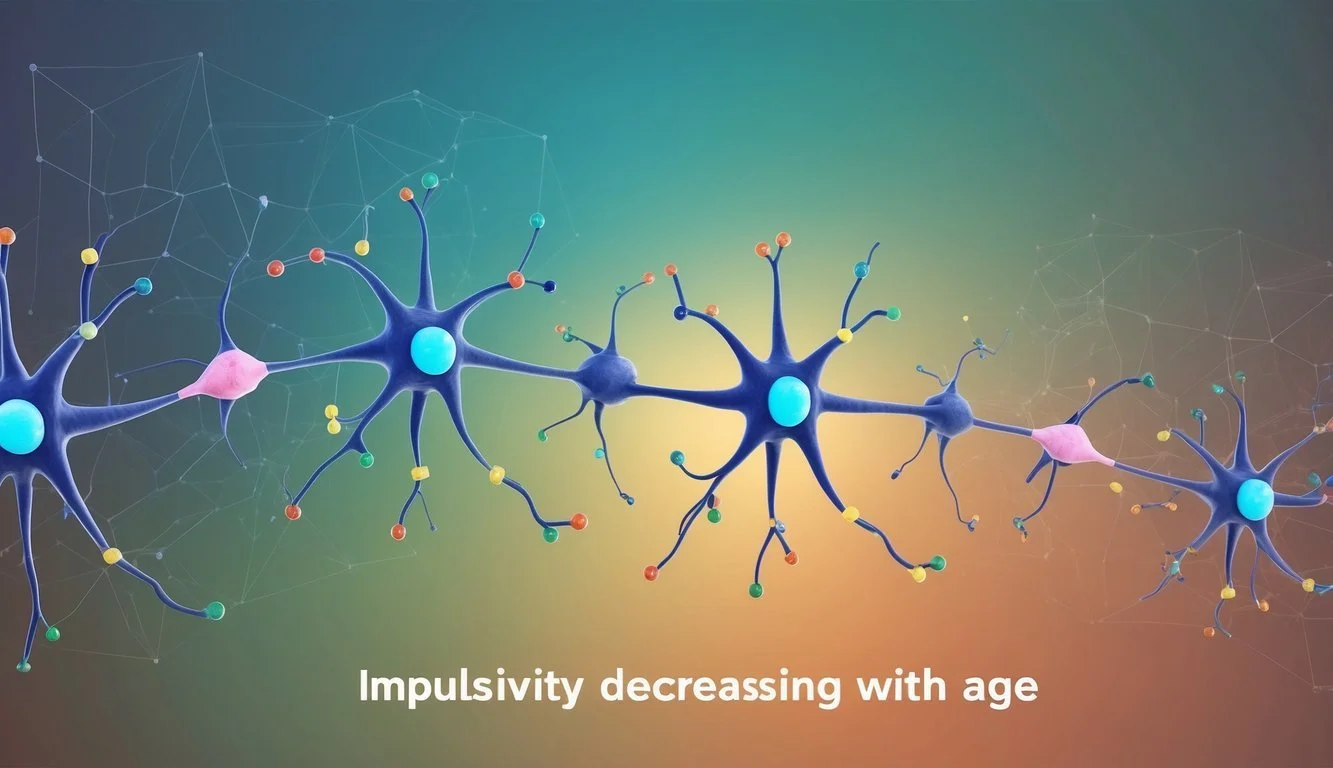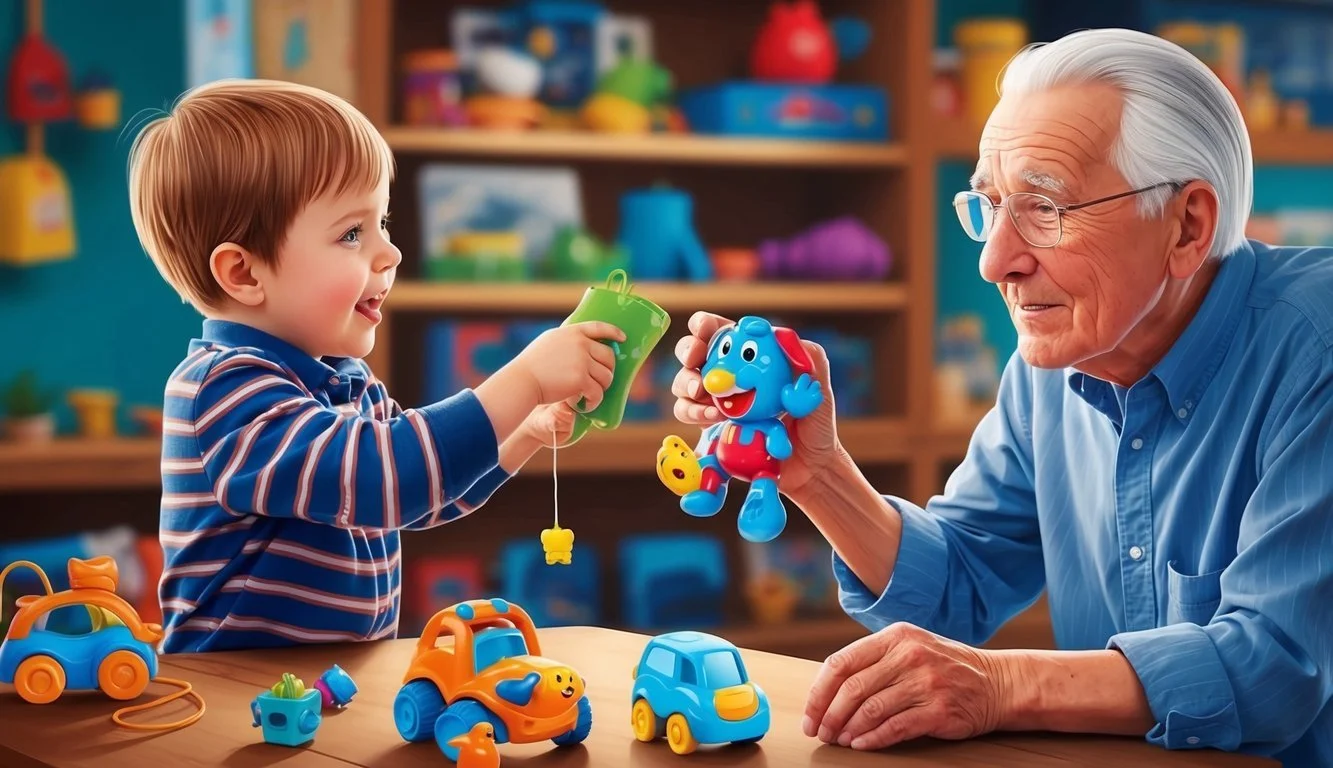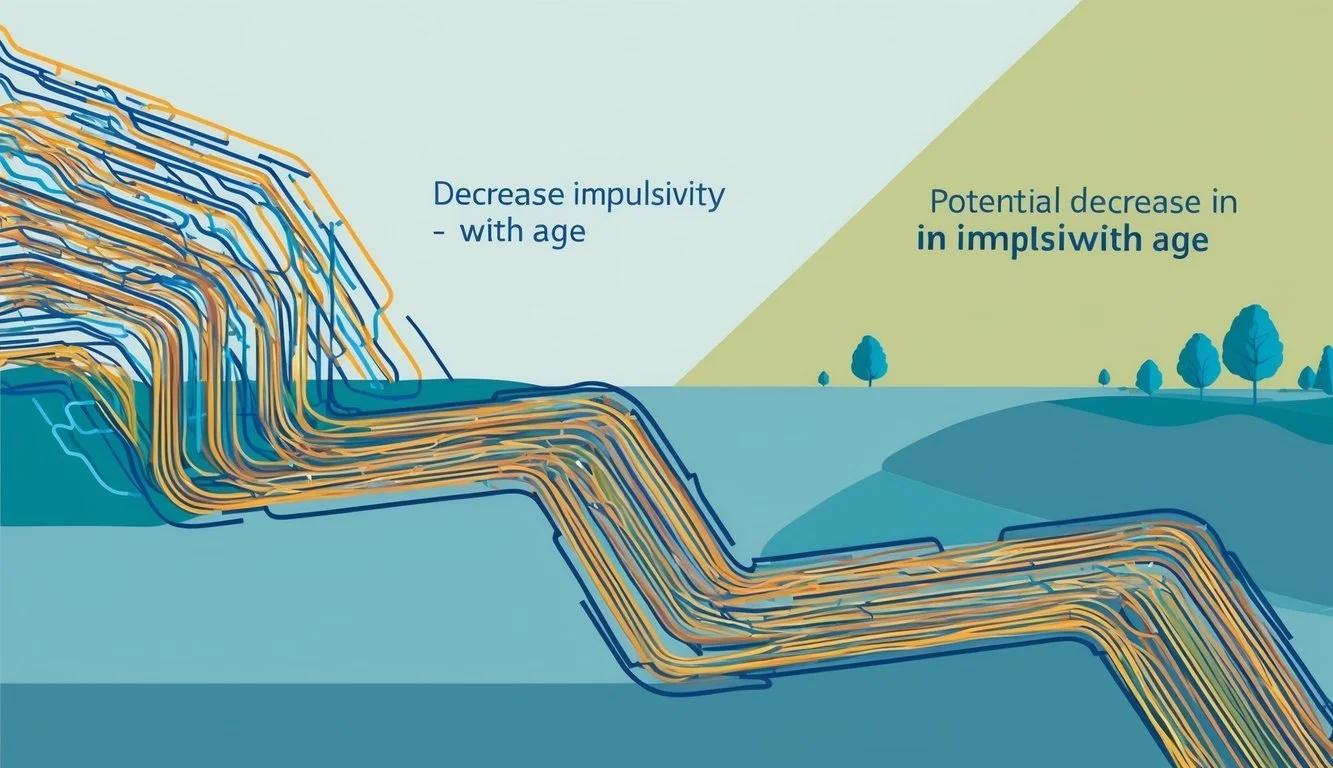Does Impulsivity Decrease with Age? Unpacking the Science Behind Maturity
Impulsivity, a key aspect of human behavior, tends to change as we age. Research indicates that impulsive tendencies generally decrease from adolescence into adulthood. Studies show that impulsivity declines steadily from age 10 onwards, following a linear pattern unrelated to puberty.
This reduction in impulsivity is linked to brain development, particularly in regions responsible for self-control and decision-making. As individuals mature, they often gain better impulse control and exhibit more thoughtful responses to situations.
Age-related changes in impulsivity can have significant impacts on risk-taking behaviors and life outcomes. While adolescents may struggle with higher levels of impulsivity, adults typically demonstrate improved self-regulation and decision-making skills. Understanding these patterns can provide valuable insights into behavior across different life stages.
Understanding Impulsivity
Impulsivity is a complex trait characterized by quick, unplanned reactions without considering potential consequences. It manifests differently across age groups and can impact various aspects of life.
Definition and Types of Impulsivity
Impulsivity refers to the tendency to act hastily without forethought. It involves rapid, unplanned responses to internal or external stimuli without adequate consideration of negative outcomes.
Three main types of impulsivity are recognized:
Motor impulsivity: Acting without thinking
Attentional impulsivity: Difficulty focusing or concentrating
Non-planning impulsivity: Lack of forethought or planning for the future
Impulsivity can be both a personality trait and a symptom of various psychological disorders, including ADHD, bipolar disorder, and substance use disorders.
Measurement and Assessment
Impulsivity is measured through various methods, including self-report questionnaires, behavioral tasks, and neuroimaging techniques.
Common assessment tools include:
Barratt Impulsiveness Scale (BIS-11)
UPPS-P Impulsive Behavior Scale
Delay Discounting Task
Behavioral tasks often involve response inhibition or decision-making under time pressure. These assessments help researchers and clinicians quantify impulsivity levels and identify specific areas of concern.
Neuroimaging studies have linked impulsivity to activity in the prefrontal cortex and limbic system. These brain regions play crucial roles in decision-making, emotional regulation, and impulse control.
Developmental Perspectives
Impulsivity changes throughout the lifespan, following distinct patterns during childhood, adolescence, and adulthood. These shifts are closely tied to brain development and environmental influences.
Impulsivity in Childhood
Children typically display higher levels of impulsivity compared to adults. This is partly due to the ongoing development of brain regions responsible for self-control and decision-making. Young children often struggle with delayed gratification and impulse control.
As children grow, their ability to regulate impulses gradually improves. This development is influenced by both biological maturation and environmental factors, such as parenting styles and educational experiences.
By late childhood, many children show increased capacity for self-regulation, though individual differences remain significant.
Adolescent Impulsivity
Adolescence marks a period of heightened impulsivity for many individuals. This increase is linked to rapid brain development, particularly in regions associated with reward-seeking behaviors.
Teenagers often exhibit:
Increased risk-taking behaviors
Greater sensitivity to peer influence
Stronger emotional reactions
Neuroimaging studies reveal that the prefrontal cortex, crucial for impulse control, continues to develop throughout adolescence. This ongoing maturation contributes to fluctuations in impulsive tendencies during the teenage years.
Adult Impulsivity
As individuals enter adulthood, impulsivity generally decreases. This decline is associated with the maturation of brain structures involved in decision-making and self-control.
Factors influencing adult impulsivity include:
Life experiences
Personality traits
Mental health status
While most adults show improved impulse control compared to their younger selves, individual differences persist. Some adults may continue to struggle with impulsive behaviors, particularly in certain contexts or under stress.
Research suggests that impulsivity continues to decline gradually throughout adulthood, with older adults often demonstrating better self-regulation than younger adults.
Age-Related Changes in Impulsivity
Impulsivity undergoes significant changes across the lifespan due to neurological, cognitive, and behavioral factors. These shifts impact decision-making, risk-taking, and self-control in complex ways as individuals mature from childhood through adulthood.
Neurological Developments
Brain maturation plays a crucial role in impulsivity changes. The prefrontal cortex, responsible for impulse control, continues developing into early adulthood. This extended maturation process contributes to gradual improvements in self-regulation.
Research indicates age-related changes in insula cortical thickness correlate with impulsivity levels. The insula, involved in decision-making and risk assessment, shows thinning as individuals age from adolescence to young adulthood.
Neurotransmitter systems also evolve with age. Dopamine activity, linked to reward-seeking behaviors, peaks in adolescence before declining in adulthood. This shift may explain the reduction in certain impulsive tendencies over time.
Cognitive Maturation
As cognitive abilities develop, individuals become better equipped to manage impulsive urges. Executive functions, including working memory and attention control, improve throughout adolescence and early adulthood.
Decision-making processes mature, allowing for more thoughtful consideration of consequences. Older individuals often display enhanced ability to delay gratification and resist immediate rewards in favor of long-term goals.
Risk perception changes with age. Adolescents tend to focus more on potential rewards, while adults give greater weight to potential risks. This shift contributes to decreased risk-taking behaviors in many domains as people age.
Behavioral Adaptations
Life experiences shape impulsivity patterns over time. Adults often develop strategies to manage impulsive tendencies through repeated encounters with consequences of hasty actions.
Social roles and responsibilities can influence impulsive behaviors. Career demands, family obligations, and societal expectations may necessitate greater self-control in various situations.
Some studies suggest certain types of impulsivity may increase in older adults. Health-related impulsivity, such as sudden diet changes or neglecting regular check-ups, can become more prevalent in middle and late adulthood.
Environmental factors play a role in age-related impulsivity changes. Decreased peer pressure and increased autonomy in decision-making as individuals age can lead to more measured choices in many areas of life.
Factors Influencing Impulsivity with Age
Impulsivity changes throughout the lifespan due to a complex interplay of biological, environmental, and psychological factors. These influences shape an individual's ability to control impulses and make thoughtful decisions.
Genetic Factors
Genetic predisposition plays a significant role in impulsivity levels across age groups. Certain genes influence neurotransmitter systems, particularly dopamine and serotonin, which are crucial for impulse control.
Research suggests that genetic variants affecting these systems can impact impulsivity differently at various life stages. For example, some genetic factors may lead to higher impulsivity in adolescence but have less influence in adulthood.
Twin studies have shown that heritability of impulsivity traits ranges from 30% to 60%. This genetic influence interacts with developmental processes, potentially explaining why impulsivity often decreases as individuals mature.
Environmental Influences
The environment significantly shapes impulsivity across the lifespan. Early childhood experiences, parenting styles, and socioeconomic factors all contribute to the development of impulse control.
Exposure to stress, trauma, or unstable environments can increase impulsivity, particularly in younger age groups. Conversely, supportive and structured environments tend to foster better impulse control.
Education and cognitive training can improve impulse regulation skills. As individuals age and accumulate more life experiences, they often develop better strategies for managing impulsive behaviors.
Cultural norms and societal expectations also play a role. Different cultures may value and reinforce impulse control differently across age groups.
Psychosocial Aspects
Psychological and social factors significantly influence impulsivity throughout life. Self-esteem, emotional regulation, and social support networks all impact an individual's ability to control impulses.
Adolescence is often characterized by increased risk-taking and impulsivity due to ongoing brain development and social pressures. This tendency typically decreases as individuals enter adulthood and assume more responsibilities.
Life transitions, such as starting a career or becoming a parent, can lead to changes in impulsivity levels. These roles often require increased self-control and planning.
Mental health conditions like ADHD, depression, and substance abuse can affect impulsivity at any age. Treatment of these conditions may lead to improvements in impulse control over time.
Social relationships and peer influences play a crucial role in shaping impulsive behaviors, especially during adolescence and young adulthood.
Consequences of Impulsivity Across the Lifespan
Impulsivity impacts individuals in various ways throughout their lives. It affects decision-making processes, shapes social interactions, and influences health outcomes. These effects can be observed across different age groups and life stages.
Impact on Decision Making
Impulsive behavior often leads to hasty choices without considering long-term consequences. In children, this may result in poor academic performance due to rushing through assignments or failing to follow instructions. Teenagers might engage in risky activities like unsafe driving or substance experimentation.
Adults with high impulsivity may struggle with financial management, making impulsive purchases or investments. They might also face challenges in career progression due to rash decisions or difficulty following through on long-term goals.
Older adults experiencing impulsivity might be more susceptible to scams or make ill-advised changes to their retirement plans. This can have significant impacts on their financial security and quality of life in later years.
Relationships and Social Dynamics
Impulsivity can strain personal and professional relationships. Children may have difficulty forming friendships due to interrupting others or not waiting their turn. Teens might experience conflicts with parents or authority figures because of impulsive actions.
In adult relationships, impulsive behavior can lead to:
Communication problems
Trust issues
Emotional instability
Workplace relationships may suffer if an individual acts without considering colleagues' input or organizational protocols. This can hinder teamwork and career advancement opportunities.
Elderly individuals with impulsive tendencies might inadvertently alienate family members or caregivers, potentially affecting the support network crucial for their well-being.
Health and Lifestyle Outcomes
Impulsivity significantly influences health behaviors and outcomes across all age groups. Children may be prone to accidents or injuries due to acting without thinking. Adolescents might engage in substance abuse or unprotected sexual activity, leading to long-term health consequences.
Adults struggling with impulsivity are more likely to:
Develop addictive behaviors
Have poor dietary habits
Neglect regular exercise routines
Engage in risky sexual practices
These behaviors can contribute to chronic health conditions like obesity, diabetes, and cardiovascular disease. Impulsive individuals may also be less likely to adhere to medical treatments or follow through with preventive health measures.
In older adults, impulsivity can exacerbate age-related health risks. It may lead to medication non-compliance or ignoring symptoms that require medical attention, potentially worsening existing health conditions.
Interventions and Management
Effective strategies exist to address impulsivity across different age groups. These approaches focus on improving self-control and decision-making skills through targeted interventions and lifestyle modifications.
Therapeutic Approaches
Cognitive Behavioral Therapy (CBT) stands out as a primary treatment for impulsivity. CBT helps individuals identify triggers and develop coping mechanisms. It teaches techniques to pause and reflect before acting, promoting more thoughtful responses.
Mindfulness-based interventions have shown promise in reducing impulsive behaviors. These practices enhance awareness of thoughts and emotions, allowing for better impulse control.
For some, medication may be necessary. Stimulants and non-stimulant medications can help manage impulsivity, especially in cases of ADHD.
Group therapy provides a supportive environment for practicing new skills and gaining insights from peers facing similar challenges.
Lifestyle and Behavioral Strategies
Establishing routines and structure can significantly reduce impulsive behaviors. Consistent schedules create predictability, minimizing unexpected situations that might trigger impulsive responses.
Regular exercise has been linked to improved impulse control. Physical activity helps regulate mood and increases dopamine levels, potentially reducing the need for impulsive stimulation.
Adequate sleep is crucial for managing impulsivity. Sleep deprivation can worsen impulse control, making it essential to maintain a healthy sleep schedule.
Stress management techniques, such as deep breathing and progressive muscle relaxation, can help individuals stay calm in challenging situations.
Preventive Measures
Early intervention is key in preventing the development of chronic impulsivity issues. Screening programs in schools and healthcare settings can identify at-risk individuals.
Parent training programs equip caregivers with tools to foster self-control in children. These programs teach effective communication and discipline strategies.
Social skills training helps individuals navigate interpersonal situations without resorting to impulsive behaviors. This training focuses on empathy, conflict resolution, and appropriate social responses.
Creating supportive environments at home, school, and work can reduce triggers for impulsive behavior. This includes clear expectations, positive reinforcement, and opportunities for success.
Future Directions in Research
Advancing our understanding of age-related changes in impulsivity requires innovative approaches and long-term studies. Key areas for future research include tracking impulsivity over extended periods and developing new tools to measure impulsive behaviors more accurately.
Longitudinal Studies
Long-term studies following individuals from adolescence through late adulthood are crucial. These studies can reveal how impulsivity evolves across different life stages and identify factors influencing its trajectory. Researchers should focus on diverse populations to account for cultural and socioeconomic variations.
Incorporating neuroimaging techniques in longitudinal research can provide insights into brain changes associated with impulsivity over time. This approach may help pinpoint critical periods for intervention and prevention strategies.
Examining the interplay between impulsivity and other psychological factors, such as emotion regulation and decision-making, could offer a more comprehensive view of age-related changes.
Innovative Assessment Tools
Developing more sensitive and ecologically valid measures of impulsivity is essential. Virtual reality simulations can recreate real-world scenarios to assess impulsive behaviors in controlled environments.
Mobile technologies and wearable devices present opportunities for continuous, real-time monitoring of impulsive tendencies in daily life. These tools can capture subtle fluctuations and contextual factors influencing impulsivity.
Combining behavioral tasks with physiological measures, such as heart rate variability or skin conductance, may provide more objective indicators of impulsive responses. This multi-modal approach could enhance the accuracy of impulsivity assessments across different age groups.
Conclusion
The relationship between impulsivity and age is complex and multifaceted. Research indicates that certain aspects of impulsivity decline with age, while others may remain stable or even increase.
Functional impulsivity, associated with quick decision-making in beneficial situations, tends to stay relatively constant across the lifespan. This suggests that older adults can maintain the ability to act swiftly when appropriate.
Dysfunctional impulsivity, linked to rash and potentially harmful actions, shows a more nuanced pattern. Some studies indicate a decrease in dysfunctional impulsivity as people age, while others suggest it may increase in later life.
Adolescence marks a critical period for impulsivity development. Teenagers often exhibit higher levels of sensation-seeking behavior compared to younger children and adults. This tendency typically peaks in mid-adolescence before declining.
Age-related changes in brain structure and function contribute to shifts in impulsivity. Maturation of prefrontal cortex regions involved in self-control continues into early adulthood, potentially explaining reductions in certain impulsive behaviors.
Individual differences play a significant role in impulsivity trajectories. Factors such as genetics, environment, and life experiences influence how impulsivity evolves throughout a person's lifetime.







